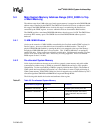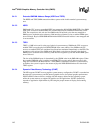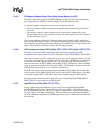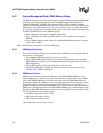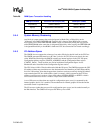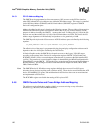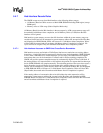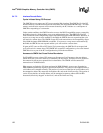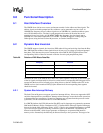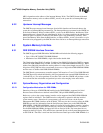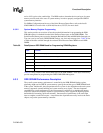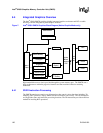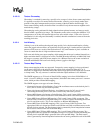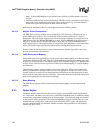
Functional Description
D15343-003 123
6.0 Functional Description
6.1 Host Interface Overview
The GMCH front side bus uses source synchronous transfer for the address and data signals. The
address signals are double pumped and two addresses can be generated every bus clock. At
100-MHz bus frequency, the two address signals run at 200 MHz for a maximum address queue
rate of 50-M addresses/sec. The data is quad pumped and an entire 64-B cache line can be
transferred in two bus clocks. At 100-MHz/133MHz bus frequency, the data signals run at
400 MHz for a maximum bandwidth of 3.2/4.3GB/s. The GMCH supports a 8-deep IOQ (In-
Order-Queue) using the Intel Celeron M processor, or Genuine Intel® Processor.
6.2 Dynamic Bus Inversion
The GMCH supports dynamic bus inversion (DBI) when driving and receiving data from the Host
Bus. DBI limits the number of data signals that are driven to a low voltage on each quad pumped
data phase. This decreases the power consumption of the GMCH. DINV[3:0]# indicates if the
corresponding 16 bits of data are inverted on the bus for each quad pumped data phase:
Table 29. Relation of DBI Bits to Data Bits
Whenever the CPU or the GMCH drives data, each 16-bit segment is analyzed. If more than eight
of the 16 signals would normally be driven low on the bus the corresponding DINV# signal will be
asserted and the data will be inverted prior to being driven on the bus. Whenever the CPU or the
GMCH receives data it monitors DINV[3:0]# to determine if the corresponding data segment
should be inverted.
6.2.1 System Bus Interrupt Delivery
The Intel Celeron M processor support system bus interrupt delivery. It does not support the APIC
serial bus interrupt delivery mechanism. Interrupt related messages are encoded on the system bus
as Interrupt Message transactions. System bus interrupts may originate from the processor on the
system bus, or from a downstream device on the Hub interface.
In a GMCH platform, the ICH4-M contains IOxAPICs and its interrupts are generated as upstream
Hub interface Memory Writes. Furthermore, PCI 2.2 defines MSI's (Message Signaled Interrupts)
that are also in the form of Memory Writes. A PCI 2.2 device may generate an interrupt as an MSI
cycle on its PCI bus instead of asserting a hardware signal to the IOxAPIC. The MSI may be
directed to the IOxAPIC, which in turn generates an interrupt as an upstream Hub interface
memory write. Alternatively the MSI may be directed directly to the system bus. The target of an
DINV[3:0] Data Bits
DINV[0]# HD[15:0]#
DINV[1]# HD[31:16]#
DINV[2]# HD[47:32]#
DINV[3]# HD[63:48]#



